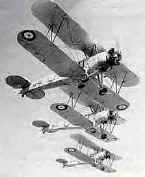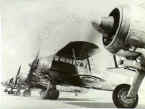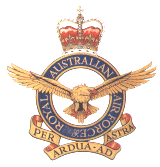 |
Avro Cadet: The
Cadet was a two-seat biplane trainer. Production was small, with 36
model 641 and 69 model 643 aircraft. The original design was intended
for flying clubs, but the Cadet Mk.II was a military trainer. The most
important customer was the RAAF, which bought 34. A number of them still
airworthy in Australia.
|
 |
Beechcraft 17.
The RAAF flew some of these but as
the photo shows so did the NAZI aligned Finnish Air Force. Three
Beechcraft "Staggerwings" served in RAAF colours. Serialled
A39-1 to 3 they were impressed into service during 1941 and 1942,
serving (A39-1 and 2) with Nos 2 and 3 Communications Flights and
(A39-3) with 36 Squadron and 2 and 4 Communications Flights. The first
two machines were transferred to the Department of Civil Aviation in
September, 1944, while A39-3 was sold to civil aviation in 1947. |
 |
Bell P-39
Airocobra. Altogether 9,588 units
of the Airocobra were built, and they were used with some success,
especially in the Pacific theatre and North Africa. In the Pacific
they made an important contribution to the Allied effort during the
Guadalcanal campaign and later offensives in the Solomons and New Guinea
- mainly as a ground attack aircraft. |
 |
Brewster
Buffalo About
200 land-based versions were bought by the British, who called it the
Brewster Buffalo; they were sent to the Far East in an attempt
to free up Spitfires and Hurricanes in Europe. Used in the defence of
Burma and Singapore, the Buffalo was overmatched by the Japanese and
eventually withdrawn from service. |
 |
Bristol
Bulldog In 1940, the last three
Bulldogs, A 12-1, -3 and -6, were taken off strength, and at least two
were transferred to the Melbourne Showgrounds and became instructional
airframes at the Engineering School. Thus, the single-seat fighter faded
from the Australian scene, until the Kittyhawks arrived in 1942 to carry
on the tradition so diligently established by the Bristol Bulldog. |
 |
CAC Woomera The
Woomera was designed to be the successor to the Bristol Beaufort in
Australian service. A radical design with the engine nacelles each
containing a remote control barbette for two 0.303in machine guns and
four 113kg (250lb) bombs. An additional four 227kg (500lb) bombs or two
2in (533mm) torpedoes could be carried under the fuselage. One prototype
(A23-1001) and one production example (A23-1) was complete by July 1944.
The rest of the 105 unit order was cancelled as the RAAF had lost
interest due to the availability of American designed light & medium
bombers such as the B-25 Mitchell. |
 |
Cessna
Airmaster When various civilian
aircraft were taken into Australian military service in World War 2,
C-34 VH-UYG, then on charter operations from Mascot Airport, Sydney with
Airflite Pty. Ltd., became the RAAF's A40-1 from July 1941. It served
with a mixture of aircraft types in 2 Communications Flight |
 |
Curtis Shrike
(Helldiver) One of the most
successful dive-bombers used by the allies, the Helldiver's development
started out rather slow. The US services asked for 880 changes after the
design had been accepted for production and to further complicate things
the prototype crashed. The changes were necessary to try and standardize
the design for all three American services. The type was designated the
A-25 Shrike
for the US Army and the Cleveland
by the RAF, who used the type briefly. From 1943 on the Helldiver flew
in nearly every major action in the Pacific war. |
 |
De Havilland
Dragon A34-68 was delivered to the
RAAF in 1943, and was then used by the No1 Wireless Air Gunners School
at Ballarat in Victoria. Following its military service, the aircraft
joined Butler Air Transport as VH-AEF in 1945 before moving on to Qantas
in 1948, and was used in New Guinea before being chartered by TAA for
service in New South Wales. |
 |
De Havilland
Dragon Rapide Many
British aircraft were impressed into military service in 1939 and did sterling
work as a communications aircraft despite looking increasingly archaic
in a world of monoplanes. |
 |
De Havilland
Dragonfly 67 built. A smaller version
of the Dragon Rapide. |
 |
De Havilland
Fox Moth The Fox Moth was a
biplane transport built up from DH 82 Tiger Moth components, with a
large cabin behind the engine, and the pilot's cockpit moved aft. 154
built. This rather unusual design accommodates four passengers in
enclosed cabin, the pilot occupying an outside "dicky" seat
aft of the wings. |
 |
De Havilland
Glider Designed and built by
De Havilland Aircraft at Bankstown NSW, two DHA-G2 prototypes were built
(A57-1001 and 1002) and handed over to the RAAF on 11th November, 1942.
It was envisaged that they would be produced in large numbers to fly
troops to meet any Japanese invasion, and would be towed by such
aircraft as the Fairey Battle and Vultee Vengeance. When the invasion
threat did not materialise only six aircraft were produced with longer
wings and fuselages than the two prototypes. The first aircraft (A57-1)
was delivered to the Aircraft Research and Development Unit on 5th May,
1943and was used for test on the Griffith suction wing, and after
alteration by the Government Aircraft Factory was fitted with a 96 hp
Mercury 59A engine for testing as a GlasII Suction Wing Glider. The
remaining aircraft (A57-2 to 6) were little used and were reduced to
components by 1952. A subsequent 15 place glider design, GC-4A, was
proposed but never built. |
 |
De Havilland
Moth By 1930 the Gipsy Moth had
become England's most popular light plane for private flying.
Inexpensive and easy to fly, the biplane made private flying possible
for thousands of Britons. To meet the demand for this dependable
aircraft, the de Havilland Company had to increase production from less
than one aircraft per week to more than three per day. It wasn't long
before 85 out of every 100 private planes in England were Moths produced
by de Havilland.
Not only did this
aircraft popularize private flying but it also accounted for a number of
flight records. In 1930 Francis Chichester, after only 100 hours
of flying time, piloted a Gipsy Moth solo from England to Australia, and
Amy Johnson matched his feat, becoming the first woman to make the
flight.
Throughout the 1930s,
the Moth was produced in several different versions. Finally,
prior to World War II, it was modified for use as a military training
plane and renamed the Tiger Moth. Most of the Royal Air Force
pilots who fought in the Battle of Britain received their flight
training in the Tiger Moth.
|
 |
De Havilland
Moth Minor shown here in its
cabin form, is one of the most recent additions to the light two-seater
low-wing monoplane type. (Written c 1930)
It is powered by the 90 h.p. Gipsy Minor engine driving a fixed pitch
wooden air-screw. Seating is in the tandem position and the
"coupe"' top is hinged, Petrol is stored in the left wing and
luggage in the right, and the wings fold for convenient storage on the
ground. |
 |
Dornier Do 24K.
Built by Aviolanda in Holland for
the Dutch East Indies Naval airforce, six survivors of some 30 original
aircraft escaped to Australia early in 1942 and five were immediately
impressed into RAAF service as A49-1 to 5. These aircraft were in poor
condition when received, but served in the transport role with 41
Squadron, flying cargo into Goodenough Island, Milne Bay and Port
Moresby. Two of them later served with 8 Communications Unit in the
search and rescue role. The sixth machine escaped to Perth from a
Japanese bombing raid on Broome and served the Dutch Intelligence Agency
on clandestine flights to New Guinea until handed over to become A49-6
in RAAF colours in October, 1943. All aircraft were withdrawn from
service and scrapped in November, 1944. |
 |
Douglas
Dolphin (Amphibian) Two Dolphins
(A35-1 and 2) operated in New Guinea on oil survey work with civilian
operators until impressed into RAAF service in June and August, 1940.
A35-3 entered service in October, 1942 while the fourth example was
shipped to Australia from the US in April,1943, having a very short
service life and being reduced to components after an accident in June
that year. The first machine was converted to components in June, 1940,
the second was deleted in February, 1944 after an accident, while A35-3
was sold in May, 1945. |
 |
Douglas DC-2
Development of the DC-3 traces
back to the earlier one off Douglas Commercial 1 (DC1) and subsequent
DC2 which made their first flights in 1933 and 1934 respectively. In
1934 American Airlines requested that Douglas develop a larger more
capable version of the DC2 for transcontinental US sleeper flights. The
resulting DC-3 (or DST - Douglas Sleeper Transport as it then was) flew
for the first time on December 17 1935 and became a legend. |
 |
Fairchild 24
Manufactured by the Fairchild
Airplane Manufacturing Corporation in Hagerstown, Md., ninety Model 24G
and twenty-five Model 24H were sold right up to the time of the Pearl
Harbor attack and for a short time after the war. Production ceased in
1947. During World War II the Model 24G saw service with the Army Air
Force as the UC-61 Forwarder
and with the Royal Air Force as the
Argus. |
 |
Ford Trimotor
was based on the general layout of
the highly successful Fokker F.VII/3m (q.v.) three-engined high-wing
monoplane, except that the Ford was all-metal --- even to its corrugated
metal skinning which earned it the nickname "Tin Goose". |
 |
Gloster
Gladiator1940-11-05. Helouan
airport - a Squadron of Gladiator fighter planes piloted by members of
the 3 Squadron RAAF; these are same planes & pilots that recently
accounted for a flight of Italian aircraft over the Western Desert -
during which encounter Squadron Leader Heath lost his life.
(negative by d. Parer)
|























